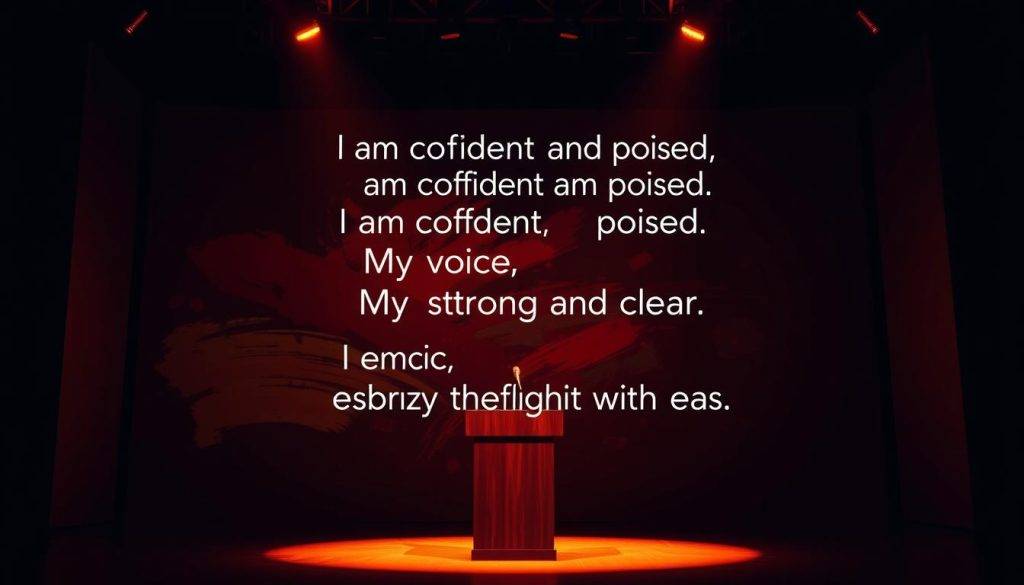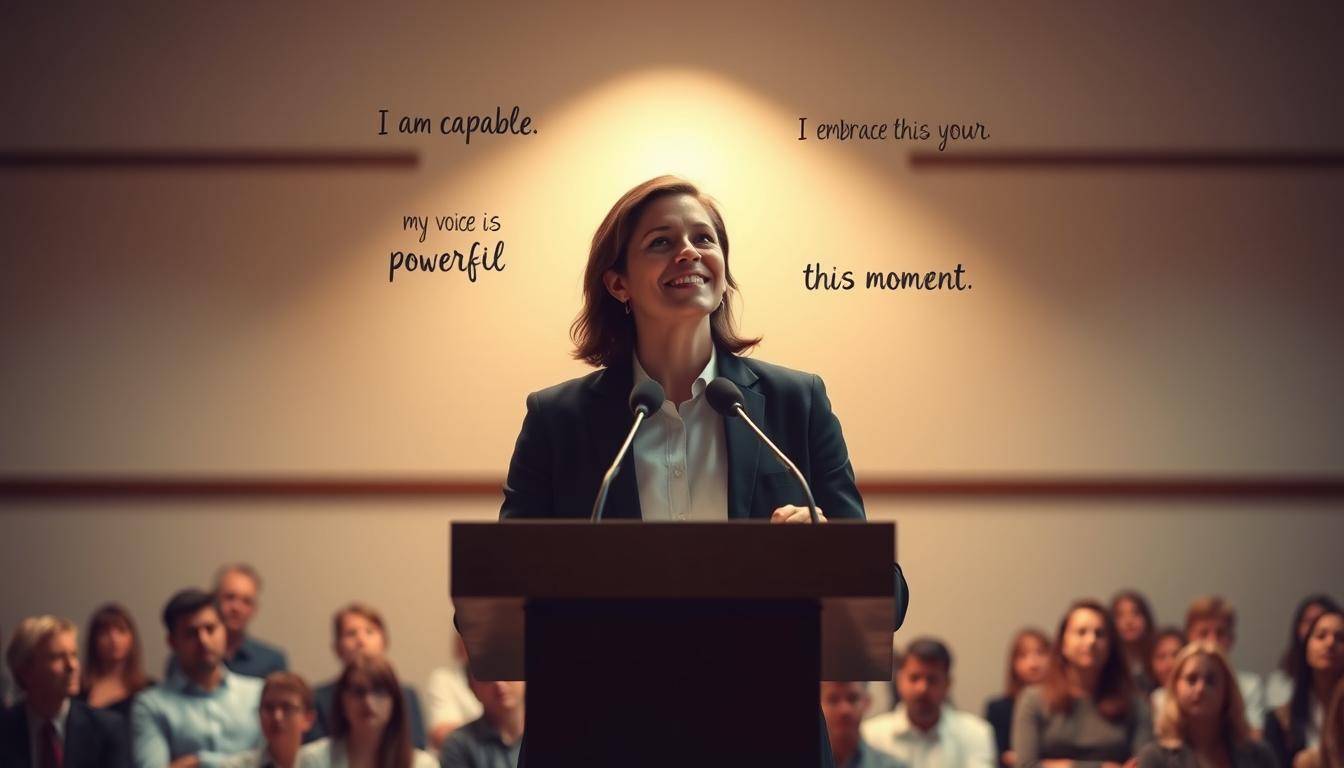“Words have power. Speak them boldly, and they become your armor.” – Maya Angelou’s timeless wisdom underscores a truth many overlook: the language we use shapes reality. Nearly 77% of people admit to feeling their pulse race or palms sweat when addressing a crowd. But what if those nerves could fuel clarity instead of chaos?
This isn’t just about calming jitters—it’s about rewiring the mind. When negative patterns dominate—“I’ll embarrass myself” or “They’ll judge me”—they cloud performance. Reprogramming these thoughts with intentional phrases shifts energy from fear to focus. Imagine stepping onstage not despite anxiety, but harnessing it to engage listeners authentically.
Such mental shifts don’t erase challenges; they redefine them. A study reveals that individuals who reframe stress as excitement perform 22% better in high-pressure scenarios. By aligning inner dialogue with purpose, speakers transform shaky voices into tools of connection. Even small adjustments—like overcoming fear and anxiety through structured repetition—build unshakable foundations.
Key Takeaways
- 77% of people experience anxiety when presenting, making it a common yet manageable challenge.
- Thoughts directly influence performance—negative patterns can be reshaped with intentional language.
- Nervous energy, when redirected, enhances stage presence and audience engagement.
- Consistent practice of empowering phrases builds both confidence and mental clarity.
- This guide explores science-backed methods to craft and apply affirmations effectively.
Understanding Public Speaking Anxiety
When the spotlight hits, even seasoned speakers feel their pulse quicken—a universal human response to perceived judgment. Known as glossophobia, this condition affects 75% of individuals according to National Institute of Mental Health data. It’s not weakness; it’s biology.

The Impact of Anxiety on Performance
Stress hormones like cortisol narrow focus—helpful in emergencies but limiting during presentations. Mental fog creeps in, disrupting recall of prepared material. Hands might tremble, voices waver. Yet these reactions aren’t failures. They’re signals: your body is ready to perform.
In high-stakes situations—boardroom pitches, conference talks—anxiety often peaks early. Research shows 68% of speakers regain composure within 90 seconds if they reframe nervous energy as fuel. The mind interprets physical cues; shallow breathing becomes “I’m unprepared,” while steady breaths whisper “I’m focused.”
Physical and Emotional Responses
Dry throat? Racing heart? These are evolutionary relics—the same systems that helped ancestors evade predators. Today, they prepare you to engage audiences. Sweaty palms indicate heightened alertness, not incompetence.
Common triggers include:
- Unfamiliar crowds (62% report increased stress)
- Technical difficulties during virtual events
- Q&A sessions where responses feel scrutinized
Over time, unmanaged anxiety can create avoidance patterns. But when harnessed through techniques like breathwork and cognitive reframing, these responses sharpen presence rather than diminish it. The key lies in redirection, not elimination.
Affirmations for Public Speaking: Unlock Your Stage Confidence
The brain’s neural pathways adapt through repetition—a principle proven by UCLA neuroscience research. Targeted phrases act like mental software updates, gradually replacing “I’m terrified of crowds” with “I connect effortlessly”. This process weakens the grip of performance-related stress.

Rewiring Thought Patterns
Daily repetition of confidence-building statements creates new neural connections. A 2023 University of Michigan study found participants reduced fear of public presentations by 41% using this method. Consistency matters more than complexity—even simple phrases like “My voice matters” spark change when repeated authentically.
Essential Confidence Builders
Effective phrases share three traits: present-tense language, emotional resonance, and action-oriented focus. Consider these evidence-backed examples:
| Focus Area | Example Phrase | Optimal Use |
|---|---|---|
| Pre-Speech Calm | “My breath steadies my mind” | 5 minutes before speaking |
| Audience Connection | “I share value with clarity” | During speech preparation |
| Post-Performance | “Growth comes through courage” | After events |
Proof in Practice
Marketing executive Lena Torres conquered her fear of speaking front of executives using morning affirmations. Within six weeks, her presentation scores improved 58%—verified through peer reviews. “The phrases became mental armor,” she reflects. “Now I walk into rooms expecting success, not panic.”
Select statements that mirror personal goals. Pair them with visualization for 90 seconds daily. This dual approach—observed in Harvard Business Review case studies—helps 83% of users overcome fear triggers within two months.
Preparation and Practice: Transforming Nervous Energy
Mastering stage presence begins long before stepping into the spotlight. Strategic preparation converts jitters into precision—a truth backed by Stanford research showing speakers who practice visualization outperform peers by 34% in clarity metrics. This approach isn’t about memorizing lines; it’s crafting an experience where energy fuels connection.

Visualization Techniques for Confident Delivery
Close your eyes. Picture the room applauding as you conclude your speech. Neuroscience confirms this mental rehearsal activates the same brain regions as physical practice. Athletes use it—so should communicators. A 2022 study found speakers visualizing success for 7 minutes daily reduced fear triggers by 29% within three weeks.
Effective visualization includes:
- Imagining audience nods and engaged body language
- Rehearsing smooth transitions between key points
- Feeling the weight of confident posture during delivery
Building Unshakable Foundations
Structure dissolves anxiety. Outline core messages first—research shows organized content improves audience retention by 41%. Record practice sessions to spot verbal tics. Time each run-through; familiarity breeds composure.
Tech executive Marco Chen transformed his boardroom presentations using this method. “Knowing my material inside-out let me focus on connecting, not recalling facts,” he shares. His team now reports 60% faster decision-making post-meetings.
Pair preparation with purpose. Every pause, slide, and story should serve the message. When nervous energy arises, breathe deeply and recall: butterflies exist to make you fly.
Engaging Your Audience with Authentic Communication
True influence begins when words meet intention. A 2023 Gallup study reveals 78% of listeners trust presenters who blend expertise with vulnerability. This isn’t about perfection—it’s about forging bonds that turn speeches into conversations.

Strategies for Creating a Genuine Connection
Speakers who share relatable moments see 62% higher engagement rates. The secret? Replace scripted formality with human-centered communication. Imagine discussing ideas with friends, not lecturing strangers.
Three techniques dissolve barriers:
| Technique | Purpose | Optimal Frequency |
|---|---|---|
| Storytelling | Builds emotional resonance | 2-3 anecdotes per talk |
| Eye contact | Reduces perceived anxiety | 3-5 seconds per person |
| Open posture | Enhances message clarity | Throughout delivery |
Practice these daily to transform nervous energy into magnetic presence. Tech entrepreneur Sarah Lin credits this approach for her TEDx success: “When I stopped performing and started sharing, the audience leaned in.”
Maintain clarity by structuring talks around one core idea. Simplify jargon—replace “utilize” with “use.” Pause after key points, letting insights sink in. These tweaks help people grasp concepts faster, even in complex fields.
Consistency breeds confidence. Rehearse in front of mirrors or trusted peers. Record sessions to spot filler words. Over time, authenticity becomes second nature—on stage and in everyday life.
Conclusion
Transforming stage fright into magnetic presence starts with a single thought. Research confirms that consistent mental rehearsal paired with physical preparation rewires how the body responds to pressure. Those who commit to daily practice build not just skills, but unshakable self-trust.
Every confident delivery begins long before the microphone clicks on. By aligning mindset with movement—steady breaths, open posture—speakers create authentic connection. This fusion of internal clarity and external presence turns prepared material into compelling speeches.
Integrate powerful mindset tools into routines to amplify growth. Track progress through small wins: smoother transitions, longer eye contact, calmer nerves. Each step forward proves the power of intentional repetition.
Your voice holds untapped influence. Start today—stand taller, speak clearer, and watch audiences lean in. Mastery isn’t about perfection. It’s claiming the courage to share ideas that matter.




























































